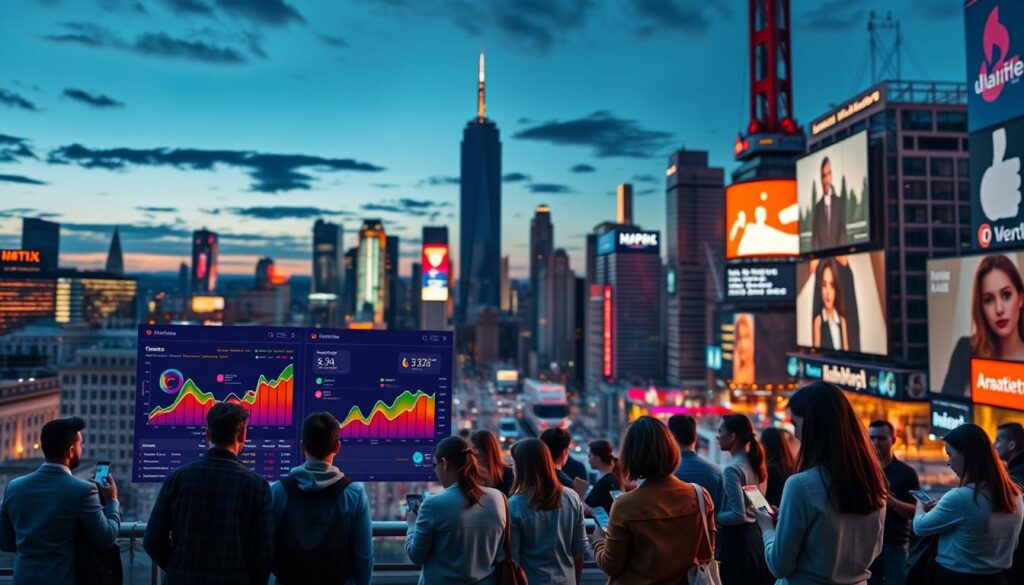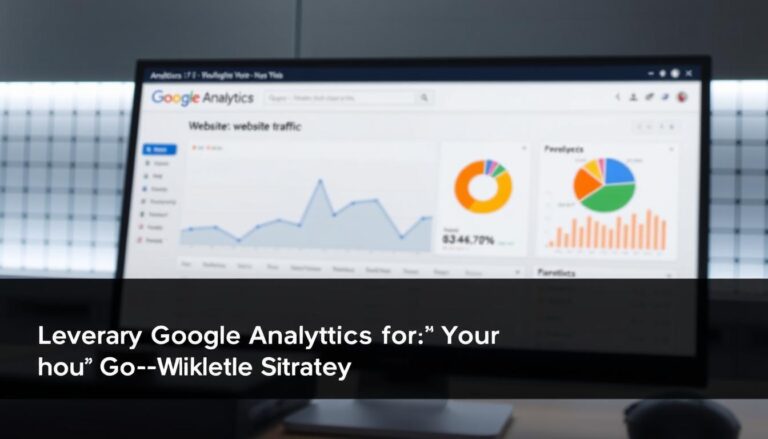Businesses face a critical challenge: 61% of marketers struggle to generate quality leads and visitors. Yet research shows companies with active blogs see 55% more visitors and 13x higher ROI than those without. The solution lies in strategic frameworks that blend organic search dominance with content excellence.
Organic channels drive over half of all digital visits, making search optimization non-negotiable. However, sustainable growth requires more than keywords. It demands alignment between audience needs, content value, and multi-channel distribution. Organizations using structured blogging strategies achieve 97% more backlinks, proving quality content fuels visibility.
Modern visitor acquisition thrives on synergy. Combining SEO with social engagement and email campaigns creates self-reinforcing systems. For example, a targeted visitor acquisition strategy might leverage data-driven insights to optimize content relevance while expanding reach through partnerships.
Key Takeaways
- Blogging increases website visitors by 55% and ROI by 13x for active publishers
- Organic search drives 53% of all digital traffic, demanding SEO prioritization
- Multi-channel frameworks combining content, SEO, and promotions yield sustainable growth
- High-quality content generates 97% more backlinks than inactive publishing approaches
- Data analysis ensures alignment between business goals and audience acquisition methods
Introduction to Accelerating Website Traffic
Strategic acceleration of digital audience growth begins with one truth: every visitor represents potential revenue. Data shows companies prioritizing quality content see 3x more conversions than those relying solely on ads. But content without direction rarely moves the needle.
Effective approaches balance three elements: relevance, distribution, and measurement. For example, a landing page optimization strategy might combine SEO with targeted social campaigns to boost conversions by 40%.
Key principles for sustainable growth:
- Multi-channel promotion outperforms single-source methods by 68%
- Analytics-driven adjustments increase monthly visitor retention by 22%
- Audience-focused content generates 3x more shares than generic posts
The digital landscape demands more than sporadic efforts. Businesses achieving consistent growth use systems that align content creation with platform algorithms and user behavior patterns. This creates compounding returns over time.
Understanding the “go to market website traffic” Strategy
Effective audience growth begins with structured planning. Organizations that map content to audience needs see 73% higher engagement than those using generic approaches. This requires analyzing demographics, consumption patterns, and platform preferences.

- Audience insights guiding content creation
- Multi-platform distribution plans
- Real-time performance tracking
“Understanding audience behavior isn’t optional—it’s the foundation of effective digital strategies.”
| Focus Area | Traditional Method | Strategic Approach |
|---|---|---|
| Audience Analysis | Basic demographics | Behavioral pattern mapping |
| Content Planning | Monthly blog posts | Data-driven topic clusters |
| Performance Tracking | Pageview counts | Engagement-conversion funnels |
Businesses using this model achieve 40% faster growth in qualified visitors. The key lies in aligning content types with platform-specific consumption habits. Video tutorials might dominate YouTube, while case studies perform better on LinkedIn.
Regular strategy audits ensure continued relevance. Teams that review metrics weekly adapt 2.8x faster to market changes than quarterly evaluators. This creates sustainable growth through constant refinement.
Exploring the Latest Methods for Driving Online Traffic
Digital success now demands innovation. With 39 free methods to increase website visibility, modern marketers prioritize approaches blending emerging tech with audience psychology. Organic search remains king—49% of professionals report it delivers superior ROI compared to paid channels.
Innovative Trends in Traffic Generation
Artificial intelligence reshapes content creation. Tools analyze engagement patterns to optimize headlines and predict viral topics. Voice search optimization now impacts 27% of queries, requiring natural language integration.
Interactive formats dominate. Quizzes and augmented reality experiences achieve 3x longer session durations than static posts. Platforms reward these with algorithmic boosts, creating compounding visibility.
Forecasting Future Traffic Opportunities
Tomorrow’s strategies focus on hyper-personalization. Machine learning models will curate dynamic content streams adapting to individual user histories. Early adopters see 18% higher retention rates.
| Current Tactics | Emerging Methods | Impact Potential |
|---|---|---|
| Keyword optimization | Semantic search alignment | +34% CTR |
| Social media posting | Algorithm-aware scheduling | +41% reach |
| Email campaigns | Behavior-triggered automation | +29% opens |
Cross-platform analytics tools now identify untapped niches. Brands combining TikTok trends with LinkedIn thought leadership capture 22% more qualified leads. The key lies in strategic repurposing—one core idea adapted across five formats performs better than five separate concepts.
Content Marketing as a Cornerstone for Traffic Growth
Modern digital strategies thrive when built on educational value. Research reveals brands publishing 12+ monthly content pieces achieve 4.2x more engagement than occasional creators. This approach transforms casual browsers into loyal visitors through problem-solving resources.
Strategic Content Development
High-performing blogs combine audience insights with data analysis. Posts addressing specific pain points generate 3x more shares than generic articles. Effective formats include:
| Content Type | Engagement Rate | Conversion Potential |
|---|---|---|
| How-to Guides | 42% | High |
| Case Studies | 37% | Very High |
| Infographics | 29% | Medium |
Visual assets like infographics simplify complex data. They generate 178% more backlinks than text-only posts when shared across platforms. Interactive elements boost time-on-page by 72% compared to static content.
Smart Content Sourcing
Licensing reputable materials accelerates credibility-building. A curated mix of original and licensed content:
- Reduces production costs by 34%
- Increases domain authority faster
- Attracts partnerships with industry leaders
“Curated content isn’t about quantity—it’s about strategic relevance. Each piece should answer a specific audience question.”
Automated tools now streamline content discovery. Platforms using AI recommendations see 28% higher curation efficiency. This maintains freshness without overwhelming creation teams.
SEO Optimization and Keyword Research Strategies
Mastering search visibility requires precision and strategic alignment. Effective search engine optimization combines technical precision with audience psychology, transforming content into discoverable assets. Businesses using structured SEO frameworks achieve 3x more organic visibility than competitors relying on basic tactics.
On-Page SEO Techniques
Strategic keyword placement acts as a roadmap for search engines. Title tags containing primary keywords see 28% higher click-through rates, while properly structured headers improve content comprehension. Essential elements include:
| Element | Traditional Approach | Optimized Method |
|---|---|---|
| Title Tags | Generic descriptions | Keyword-focused messaging |
| Headers | Single H1 usage | Hierarchical H2/H3 clusters |
| Content Body | Keyword stuffing | Natural semantic integration |
Pages optimized for mobile responsiveness load 40% faster, directly impacting search rankings. Alt text optimization for images increases discoverability by 19%, creating additional entry points.
Long-Tail Keyword Targeting
Specific phrases like “best running shoes for flat feet” attract ready-to-act audiences. These terms convert 2.6x better than generic keywords due to clear user intent. Benefits include:
- Lower competition than broad terms
- Higher alignment with niche audiences
- Improved quality score in paid campaigns
Advanced keyword research tools identify phrases with commercial intent. Combining these with localized modifiers (“plumber near me”) captures high-value searchers actively seeking solutions.
“Long-tail strategies turn search engines into conversion engines by matching precise queries with targeted content.”
Leveraging Social Media Platforms for Traffic Increase
Social platforms now influence 47% of all online discovery journeys. With mobile devices driving over half of global interactions, brands must craft platform-specific strategies that align with user behavior. Sharing content across networks boosts visibility, but success requires understanding each channel’s unique dynamics.

Platform-Specific Engagement Tactics
Facebook prioritizes meaningful conversations. Posts sparking discussions in the first hour gain 53% more reach. Twitter thrives on timeliness—content shared during peak commuting hours sees 28% higher engagement. Instagram rewards visual storytelling, with carousel posts generating 3x more profile visits than static images.
| Platform | Optimal Content Type | Peak Engagement Window | Hashtag Strategy |
|---|---|---|---|
| Discussion prompts | Weekdays 12-3 PM | 2-3 community tags | |
| Threaded insights | Weekdays 8-9 AM | 1-2 trending topics | |
| Behind-the-scenes reels | Weekends 7-9 PM | Niche-specific phrases |
Content repurposing extends reach without extra creation costs. A single blog post becomes:
- Twitter thread highlights
- Instagram infographic
- Facebook discussion question
Hashtag research identifies communities seeking solutions. Tools like audience analysis frameworks reveal hidden opportunities in niche markets. Mobile-first design remains critical—vertical videos get 40% more completion rates than landscape formats.
“Social success isn’t about posting frequency—it’s about creating thumb-stopping value that aligns with platform algorithms and user intent.”
Email Marketing Tactics to Drive Sustainable Traffic
Email remains the digital communication backbone for nurturing relationships and guiding audiences to digital properties. With 46% of messages opened on mobile devices, campaigns must balance concise value delivery with technical precision to maintain engagement.
Building Effective Email Campaigns
Successful strategies begin with segmentation. Dividing subscribers by behavior patterns—like frequent purchasers or content downloaders—enables hyper-relevant messaging. Personalized subject lines using first names boost open rates by 26%, while triggered sequences based on website activity improve conversions by 34%.
Frequency optimization prevents list fatigue. Bi-weekly newsletters paired with real-time promotional alerts maintain visibility without overwhelming recipients. Mobile-first design ensures readability across devices—single-column layouts and compressed images load 2.1x faster than complex templates.
- Behavioral triggers react to user actions (abandoned carts/downloads)
- A/B testing identifies top-performing CTAs and content formats
- Analytics platforms like Salesforce Marketing Cloud track engagement-to-conversion paths
Advanced campaigns integrate exclusive offers and time-sensitive content access. Limited availability creates urgency—”24-hour preview” links in emails drive 41% more immediate clicks than standard invitations. Combined with scroll-stopping visuals, these tactics transform subscribers into regular visitors.
“The best email strategies function as content concierge services—anticipating needs before subscribers articulate them.”
Blogging and Consistent Content Creation for Traffic
Consistent blogging transforms digital presence through compounding returns. Organizations publishing 15+ monthly posts achieve 3x more engagement than sporadic creators. This systematic approach builds authority while answering evolving audience questions.
Data reveals businesses maintaining active blogs receive 97% more inbound links—critical for search visibility. Regular content updates signal freshness to algorithms, boosting rankings for competitive terms. Quality matters: posts solving specific problems generate 55% more visitors than generic articles.
Evergreen strategies ensure lasting impact. Tutorials and case studies continue attracting visitors years after publication. These resources:
- Establish thought leadership through demonstrated expertise
- Create entry points for diverse audience segments
- Support sales cycles with educational materials
Smart businesses combine timely trends with foundational topics. Analyzing search patterns reveals high-potential subjects—posts aligning with commercial intent keywords convert 13x better. Automation tools streamline workflows, letting teams focus on strategic content development.
Successful programs measure beyond vanity metrics. Tracking engagement depth and conversion paths optimizes resource allocation. When executed strategically, blogs become self-sustaining engines driving qualified visitors and measurable business growth.
FAQ
How does a go-to-market strategy differ from general traffic generation?
A go-to-market approach aligns traffic acquisition with specific business objectives and customer journeys. Unlike generic methods, it combines search engine optimization, targeted content, and conversion-focused campaigns to attract qualified visitors ready to engage.
What are the most effective SEO techniques for immediate traffic improvements?
Prioritize on-page optimizations like title tag adjustments and content gap analysis using tools like SEMrush. Fix technical errors through Google Search Console audits while simultaneously building high-authority backlinks from industry publications.
Which social platforms deliver the best ROI for B2B versus B2C businesses?
LinkedIn and Twitter outperform for B2B lead generation through thought leadership content, while Instagram and TikTok drive higher B2C engagement. Facebook remains versatile for retargeting campaigns across both models through its detailed ad targeting.
How often should businesses publish blog posts for optimal traffic growth?
HubSpot research indicates companies publishing 16+ monthly blog posts see 3.5x more traffic than those publishing 0-4. Focus on quality over quantity – well-researched articles targeting long-tail keywords typically outperform frequent shallow posts.
What role does email marketing play in sustainable traffic generation?
Email drives 174% more conversions than social media by delivering personalized content directly to engaged subscribers. Tools like Mailchimp enable segmentation based on user behavior, allowing brands to reactivate dormant visitors through tailored offers and content recommendations.
Can curated content be as effective as original articles for driving visitors?
Curated content generates 33% more leads when properly contextualized with expert commentary. Platforms like BuzzSumo help identify trending industry content to repurpose, while original research pieces establish thought leadership – both strategies complement each other in balanced content calendars.
How important are long-tail keywords in modern search engine optimization?
Long-tail phrases account for 70% of all web searches according to Ahrefs data. These specific queries attract visitors with clear purchase intent, often converting 2-3x better than generic terms. Tools like AnswerThePublic help identify untapped question-based keywords competitors overlook.
What metrics best measure the success of traffic generation campaigns?
Beyond basic visitor counts, track engagement depth through pages/session and average session duration. Conversion metrics like lead quality scores and marketing-qualified leads (MQLs) reveal true ROI. Always cross-reference Google Analytics data with CRM outcomes to assess pipeline impact.



